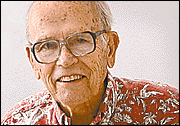


Hawaii’s World
THOSE who experienced the Japanese attack on Pearl Harbor on Dec. 7, 1941, are sharply diminishing in numbers. Being saved, fortunately, are good reminders of the glorious conduct thereafter of Japanese-Americans by birth and their parents who were by law denied citizenship. Memorials keep
AJA experience aliveFor this column I set out to summarize the memorials existing and planned. An engrossing living memorial to Americans of Japanese ancestry in multi-cultural Hawaii is the "From Bento to Mixed Plate" exhibit of memorabilia and taped interviews seen first at Bishop Museum here, then at the Smithsonian in Washington until last month. It will reopen at Hilo's Lyman House Museum Jan. 22, move from there to Okinawa in November, and later to Japan.
It is the property of the Japanese American Museum of Los Angeles and deserves to find a final home there. But there is so much more. The Brothers in Valor monument at Fort DeRussy honors four nisei military service units -- the 100th and 442nd, which set records for heroism in Europe, the Military Intelligence Service, which provided Japanese interpreters in the Pacific War, and the 1399th combat engineers held for construction work at Schofield Barracks.
The USS Arizona Museum and the Army Museum at Fort DeRussy tell more of the story. So does the Japanese Cultural Center of Hawaii. It has sponsored a book, "Japanese Eyes, American Heart," with personal reflections of Hawaii's World War II nisei soldiers. This adds to a substantial library of combat and internment accounts -- too vast to tackle here.
There are plaques at the Punchbowl National Cemetery. The University of Hawaii has a sculpture honoring its student Varsity Victory Volunteers, who were a labor battalion while they fought for the right to fight in the military services.
In Los Angeles, a "Go for Broke" memorial, subtitled "An American Story," was dedicated June 5 to honor all four fighting units. It is in Little Tokyo adjoining the Japanese American Museum. It carries 16,000 soldiers' names. San Francisco has a Japan Center but no particular World War II emphasis that I know of.
In Washington, D. C., close to the Capitol, ground was broken Oct. 22 for a $10.8 million national memorial to Japanese American patriotism. It will name the 10 detention camps where Japanese were confined in World War II and list 800 of their sons, many from Hawaii, who died in combat. The Manzanar Internment Camp site in Owens Valley, Calif., became a National Historic Site in 1992.
DENVER has a Japanese American Nisei Memorial completed in 1963. Seattle's Lake View Cemetery has a 21-foot Nisei War Memorial Monument dedicated in 1949.
On Oct. 25 a 100th Infantry Battalion Memorial was dedicated at Sacrifice Field, Fort Benning, Ga. The 100th also considers its Honolulu club-house on Kamoku Street as a memorial.
In Norfolk, Va., the MacArthur Memorial Foundation Library includes items from a former exhibit that emphasized the important role of the Military Intelligence Service nisei in the occupation of Japan. Another MIS exhibit is at the Army War College in Carlisle, Pa. In Brisbane, Australia, there is a stained glass window memorial to the MIS at St. John's Cathedral.
In Europe, a monument at Biffontaine, France, honors the 100th/442nd and the Lost Battalion. One at Bruyeres, France, honors the 442nd. Another is to be dedicated next April 25 at Pietrasanta, Italy. I fear I have missed still more.
A.A. Smyser is the contributing editor
and former editor of the the Star-Bulletin
His column runs Tuesday and Thursday.